Aspecific device for subcutaneously anchored securement (SAS) of central venous catheters (CVC) was introduced into clinical practice only a few years ago. In the authors' 1500-bed university hospital, clinicians have considered the use of such a device for the purpose of reducing or eliminating the clinical occurrence of catheter dislodgement, an often-neglected complication. In the authors' experience, CVC dislodgement is only partially prevented by current securement strategies: adoption of semipermeable transparent dressings (Tegaderm, 3M; IV 3000, Smith & Nephew); application of cyanoacrylate glue (Hystoacryl, BBraun) on the exit site; consistent use of sutureless devices, either adhesive to the skin (StatLock, BD; Grip-Lok, Zefon International; WingGuard, Centurion Medical Products) or integrated in the transparent dressing (SorbaShield, Centurion). In some patient populations within the authors' hospital (such as in children), partial or total dislodgement of the catheter is the most frequent reason for losing venous access (far more frequent than infection or venous thrombosis or lumen occlusion).
Before introducing this new device into clinical practice, the authors have considered several aspects: its applicability, its efficacy, its safety and its cost-effectiveness.
The applicability of the SAS system is inherent in its design: the device requires that at least 2-3 cm of the extra-cutaneous tract of the venous catheter should be available, so that there might be space enough for securement. This implies that the main field of application of SAS should be central venous access devices, rather than peripheral venous catheters, where the placement of the SAS device may be impossible (short peripheral intravenous cannulas) or technically difficult (midline catheters).
The efficacy of SAS—that is, the effectiveness in actually reducing the risk of dislodgement—has been addressed in many studies in the last few years, including a few clinical studies published in peer-reviewed journals (Egan Sansivero, 2012; Egan et al, 2013; Cordovani and Cooper, 2013; Hughes, 2014; Dolcino et al, 2017; Zerla et al, 2017; Goossens et al, 2018). All these studies have apparently confirmed the efficacy of the device.
The safety of SAS—the possibility of adverse effects such as allergy, pain at device placement or at removal, skin injury, infection, etc—has also been addressed in the literature (Cordovani and Cooper, 2013; Goossens et al, 2018), even if somewhat inconsistently. No clear data are available regarding the incidence of adverse effects and the possible strategies for preventing them.
Finally, the cost-effectiveness has been specifically addressed by one study (Zerla et al, 2017), which concluded in favour of the SAS device. However, considering the not irrelevant cost of the device, it appears that the actual cost-effectiveness should be different in different patient populations, as it is dependent on the actual risk of dislodgement as well as on the scheduled duration of the venous access. In other words, cost-effectiveness is probably related to the appropriate/inappropriate indication for SAS: it is expected to be maximal in patients with a high risk of dislodgement or in catheters that are meant to stay in place for the medium to long term.
Before introducing SAS in their hospital, the authors planned and carried out three different prospective clinical studies, aiming to define the efficacy, the safety and the cost-effectiveness of the SAS device in different categories of patients, so as to formulate proper indications for its use. One study (study A) was focused on PICC securement, while the other two studies (B and C) were carried out in patients with many different non-cuffed CVCs, both tunnelled and non-tunnelled.
Methods
The first two prospective clinical studies were carried out simultaneously in 2015-2016.
The first study (study A) was designed as a prospective, non-controlled clinical study on 50 oncology patients requiring peripherally inserted central catheters (PICC) for a period of not less than 8 weeks for the purpose of chemotherapy. All patients were not admitted as inpatients, they were receiving chemotherapy as outpatients, in the so-called ‘day hospital’ facilities of the oncology units of the university hospital. The rationale of this selection of patients was the fact that in this hospital the SAS device (SecurAcath, Interrad Medical) has a cost slightly less than the cost of eight skin-adhesive sutureless devices, such as the ones commonly used in the oncology units (StatLock, BD; GripLok, Zefon International). As the SAS device is placed at the moment of PICC insertion and kept in place for the whole duration of the catheter life, while the skin-adhesive sutureless devices have to be replaced weekly, the authors considered that a positive result for the SAS device in terms of efficacy would have implied automatically a favorable cost-effectiveness in this category of patients.
All patients were enrolled consecutively, as long as they met the above requirements. All PICCs (either 4 Fr single lumen or 5 Fr double lumen) were power injectable, open-ended, non-valved, in polyurethane, and they were inserted according to the SIP (Safe Insertion of PICCS) protocol described by GAVeCeLT (the Italian Group of Long Term Venous Access) (Emoli et al, 2014) and specifically adopted in this hospital's policies. All SAS (4 Fr or 5 Fr, depending on the size of the PICC) were placed and removed by specifically trained clinicians. PICC maintenance followed hospital policy (dressing change every 7 days, skin antisepsis with 2% chlorhexidine in alcohol, covered with transparent semipermeable membranes, use of neutral displacement needle-free connectors, flush and lock with saline only).
The second study (study B) was designed as a prospective, non-controlled clinical study on 50 patients requiring a non-cuffed central venous access device—either non-tunnelled or tunnelled—of different types. The types used were PICC, centrally inserted central catheter (CICC) and femorally inserted central catheter (FICC). The selection criterion was an expected 30% risk of partial (> 2 cm) or total dislodgement; considering the previous dislodgement rates recorded in the hospital, such a relevant risk was present in four categories of patients:
All patients were enrolled consecutively, as long as they met the above requirements. All catheters (PICC, CICC, FICC) were power injectable, open-ended, non-valved, in polyurethane, and they were inserted according to the insertion bundles recommended by hospital policies. All SAS devices (4 Fr, 5 Fr, 6 Fr, 7 Fr, depending on the size of the PICC) were placed and removed by specifically trained clinicians. Catheter maintenance followed hospital policy (dressing change every 7 days, skin antisepsis with 2% chlorhexidine in alcohol, coverage with transparent semipermeable membranes, use of neutral displacement needle-free connectors, flush and lock with saline only).
The third and last clinical study (study C) was carried out in 2016-2017. This was designed as a prospective, non-controlled clinical study. The authors enrolled 100 consecutive patients aged under 18 years (neonate, infants and children) who were candidates for elective placement of a non-cuffed external central venous access device—either tunnelled or non-tunnelled—inserted via a deep vein of the arm (PICC), of the supra/infra-clavicular area (CICC), or of the groin (FICC). Thus, the following were excluded: peripheral venous catheters, central catheters inserted as an emergency, totally implantable ports, tunnelled-cuffed catheters, central lines inserted in superficial veins of neonates (epicutaneo-caval catheters), and umbilical venous catheters in neonates. All catheters (PICC, CICC, FICC) were power injectable, open-ended, non-valved, in polyurethane, and they were inserted according to the paediatric insertion bundle recommended by hospital policies (pre-procedural ultrasound evaluation of the veins, ultrasound-guided venepuncture; ultrasound-based tip navigation, no fluoroscopy, tip location by intracavitary electrocardiography or echocardiography; placement of cyanoacrylate glue on the puncture site and/or exit site, covered with transparent membrane). All SAS devices (3 Fr or 4 Fr, depending on the size of the catheter) were placed and removed by specifically trained clinicians. Catheter maintenance followed hospital policy (dressing change every 7 days, skin antisepsis with 2% chlorhexidine in alcohol, covered with transparent semipermeable membranes, use of neutral displacement needle-free connectors, flush and lock with saline only).
In all three studies, patients were followed up to the time of removal of the catheter. All relevant clinical data regarding the insertion, maintenance and removal of the catheter (including minor and major complications related or unrelated to the SAS device) were carefully recorded. The endpoints of each study were to evaluate the efficacy, the safety and the cost-effectiveness of SAS in each of the three study groups.
Results
Study A
Figure 1 shows one of the secured PICCs. Two patients with PICCs were lost to follow up, so that only the data of 48 cases were analysed. PICC insertion and SAS device placement were easy and uncomplicated in all cases. All patients had subcutaneous injection of local anaesthetic (0.75% ropivacaine) before venepuncture, according to the hospital's PICC insertion policy. There were no cases of pain during SAS placement. In 28 patients, cyanoacrylate glue was also placed around the exit site, after SAS device placement.
The range of duration of PICCs was 2 weeks to 13 months (median 4 months). Twenty-six patients had the PICC (and the SAS device) in place for 2-9 months, 18 patients for more than 9 months. In 4 patients, the PICC was removed before 8 weeks; such removals before the scheduled time were not related to the SAS device. There was no occurrence of partial or total dislodgement. During maintenance, the only complication potentially related to the SAS device was a transient inflammation of the exit site (in just one patient), which did not require the removal of the device and did not shorten the life of the PICC.
The same clinicians who performed the insertion removed all PICCs; in five cases, the patient experienced some sort of pain/discomfort during removal: in two out of five of such cases, there were signs of chronic inflammation of the exit site.
Study B
Three patients with PICCs were lost to follow up, so that only the data of 47 cases were analysed. In all the authors studied 12 CICCs, 6 FICCs and 29 PICCs, of gauge ranging between 4 Fr and 7 Fr; 6 out of 47 were tunnelled non-cuffed central catheters. There were four categories of patients: 11 patients with cognitive disorder (age 71-87 years), eight children (aged 3-12 years) (see Figure 2 for an example), 22 patients with history of repeated accidental dislodgement of the central catheter, and 6 patients with skin abnormalities (three patients with medical adhesive-related skin injury and three patients with specific skin disorders) (Figure 3 shows a patient with a skin disorder).
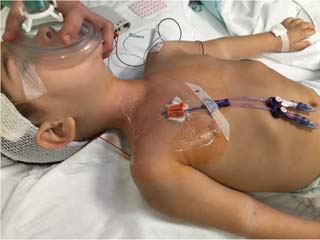
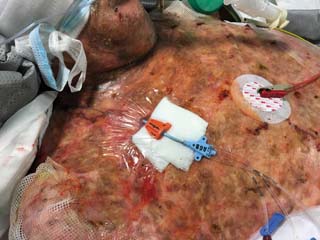
Catheter insertion was easy and uncomplicated in all cases. Some difficulties at SAS device placement were noted in two cases but there were no cases of pain during SAS device placement. In 17 patients, cyanoacrylate glue was also placed around the exit site, after SAS device placement. In 2 patients with medical adhesive-related skin injury, the SAS device was placed on PICCs that had been inserted a few weeks before and had been previously secured with a skin-adhesive sutureless device.
The range of duration of the central lines was 24 hours to 3 months (median: 2 weeks). There were no cases of partial dislodgement. There were two cases of accidental removal of the catheter, both in patients with dementia.
The same clinicians who performed the insertion removed all catheters; in five cases, the patient experienced some sort of pain/discomfort during removal: in two out of five of such cases, there were signs of chronic inflammation of the exit site.
Study C
Five patients with catheters were lost to follow up. The authors analysed 95 central catheters inserted in 83 neonates and children (age ranged between 20 days and 12 years): 52 CICCs, 6 FICCs and 37 PICCs, of gauge ranging between 3 Fr and 4 Fr; 85 out of 95 were tunnelled, non-cuffed central catheters (Figure 4) while 10 catheters were non-tunnelled (Figure 5).
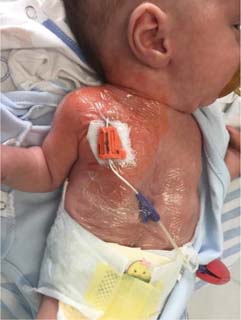
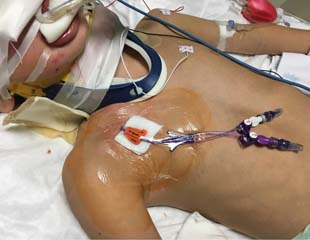
Catheter insertion and SAS device placement were easy and uncomplicated in all cases. Cyanoacrylate glue was also placed around the exit site, after SAS placement, in all cases.
The range of duration of the central lines was 5 days to 7 months (median: 3 weeks). There were no cases of partial dislodgement. There was one case of total dislodgement (accidental removal of the catheter), in one child with erosion/inflammation of the exit site. In four children with PICCs, some pain/discomfort was sometimes reported during the change of the dressing.
The same clinicians who performed the insertion removed all catheters; no patient experienced pain during SAS device removal.
Summary of the results of the three studies
The main results of the studies are summarised in Table 1. The efficacy of SAS in preventing catheter dislodgement was 98.4%. Its safety was demonstrated, since the SAS-related complications were few and of little or no relevance. Interestingly, SAS device placement was perfectly compatible with the placement of cyanoacrylate glue, which clinicians consistently use in this hospital.
| Study A | Study B | Study C | Study A+B+C | |
|---|---|---|---|---|
| Number of cases | 48 | 47 | 95 | 190 |
| Difficulty at SAS insertion | - | 2 | - | 2 (1%) |
| Pain/discomfort at SAS insertion | - | - | - | - |
| Dislodgement | - | 2 | 1 | 3 (1.6%) |
| Local inflammation | 2 | 2 | 1 | 5 (2.6%) |
| Pain/discomfort at maintenance | - | - | 4 | 4 (2.1%) |
| Pain/discomfort at removal | 5 | 5 | - | 10 (5.3%) |
The cost-effectiveness was high, in all studies. To consider study A: by using 48 SAS devices (approximately €1440), the team avoided the expenses related to the use of an exceedingly high number of skin-adhesive sutureless devices (893 weeks = 893 sutureless devices x €5.00 = €4465), giving a net saving of €3025. Furthermore, considering that in a similar case-control group of patients the risk of partial or total dislodgement was 8% and considering that the average cost of one single repositioning manoeuvre (guide-wire replacement or ex novo insertion) is approximately €105, it can be estimated that in study A there was an additional saving of approximately €420 (4 expected cases of dislodgment), meaning the final expected saving would be €3445 in that group of patients. In study B, the authors selected patient populations with expected risk of dislodgement close to 30%. This means that by using 47 SAS devices (approximately €1410) they avoided approximately 14 repositioning manoeuvres (€1470) plus the expenses related to the weekly change of skin-adhesive sutureless devices. The cost-effectiveness was even higher in study C, since the guide-wire replacement or ex novo insertion of a new catheter is quite expensive in neonates and children.
Discussion
The three clinical studies have confirmed the efficacy, safety and cost-effectiveness of SAS when adopted for securement of central venous catheters (PICC, CICC, FICC, either tunnelled or non-tunnelled) in specific populations of patients: neonates, children, non-compliant older patients, patients with skin abnormalities that may reduce the effectiveness of a skin adhesive sutureless securement, patients who are candidates for maintaining a PICC for more than 8 weeks, and any category of patients with a high risk of catheter dislodgement.
The results show that when the SAS device is applied and removed by specifically trained clinicians, the manoeuvre is extremely well tolerated. In particular, removal is usually painless: the evidence of signs of inflammation at the exit site might be an indication to remove the SAS device under local anaesthesia.
The data show that the SAS device can be safely used in combination with cyanoacrylate glue, provided that the glue is applied after SAS placement. Cyanoacrylate glue is applied for the purpose of avoiding local bleeding and protecting the exit site from bacterial contamination (Scoppettuolo et al, 2015; Biasucci et al, 2018).
The data also show that SAS is perfectly tolerated in children and even in newborns. Also, in both paediatric patients and adults, SAS can be used for securement of tunnelled non-cuffed catheters: the authors have been using SAS with great efficacy for both tunnelled non-cuffed PICCs (Figure 6) and tunnelled non-cuffed CICCs (Figure 7). A previous study has shown the clinical advantage of using SAS for securement of tunnelled cuffed catheters in children (Dolcino et al, 2017); future studies are warranted, to explore the advantages and disadvantages of using tunnelled non-cuffed catheters secured with SAS devices compared with tunnelled cuffed catheters.
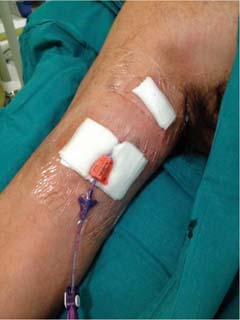
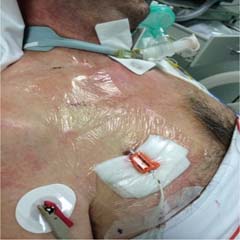
Also, future clinical studies should investigate the potential role of SAS in the prevention of catheter-related infection or catheter-related venous thrombosis, two complications that might be theoretically reduced by an improved stabilisation of the catheter.
Finally, the authors' experience with these first 190 cases has led them to make some recommendations for good clinical practice. In SAS device placement, the key factor for reducing the risk of local inflammation appears to be the insertion of the anchor deep into the subcutaneous tissue; an anchor placed in a shallow location might induce a ‘reverse’ pressure ulcer on the skin. Proper deep location of the anchor may imply an enlargement of the breech where the catheter exits the skin; the possibility of local bleeding can be avoided by sealing the breech with cyanoacrylate glue.
With regard to SAS device maintenance, in children and newborns the application of a gauze between the SAS device and the skin may be helpful in reducing the risk of pressure ulcers. Also, PICCs in paediatric patients—if secured with an SAS device—might be associated with some discomfort during dressing change, secondary to traction of the anchor. In this situation, an additional sutureless device for securing the wing of the PICC to the skin may be indicated.
Finally, considering SAS device removal, this is painless and easy if performed by splitting the SAS device in the middle, using a straight short scissor, after opening the SAS device and removing the catheter. Local anaesthesia is usually not needed, in the absence of local inflammation.
Conclusions
The three clinical studies have demonstrated a 98.4% efficacy of SAS in preventing catheter dislodgement. Also, the SAS device proved to be safe and well tolerated, since SAS-related complications were few and of little or no relevance. Finally, its cost-effectiveness was very high, in all studies.
Following the completion of these studies, local policies at the authors' hospital have changed and recommend the use of SAS for the stabilisation of the following central venous access devices:

